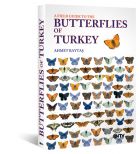Buy or gift a stand-alone digital subscription and get unlimited access to dozens of back issues for just £18.99 / $18.99 a year.
Please register at www.exacteditions.com/digital/cornucopia with your subscriber account number or contact subscriptions@cornucopia.net
Buy a digital subscription Go to the Digital EditionThe Kaçkar Mountains are heaven for butterflies, as Ahmet Baytaş, economist by trade, ecologist by nature, discovered when he returned to Yaylalar, the village of his birth
On July 15, 1999, I woke early, just before sunrise, with a sense of excitement. That evening I would be leaving my apartment in Montclair, New Jersey, for northeastern Turkey in search of butterflies. I would spend a few days around Yusufeli, in Artvin province, and a week in my birthplace, Yaylalar, a nearby village in the foothills of the Kaçkar Mountains. We had left in 1959, when I was three, for a better life in Istanbul, and I had never returned.
It was an unforgettable trip. I was swept away by the area’s breathtaking beauty, its imposing mountains, magnificent alpine meadows and, above all, the extraordinary diversity of its wild flowers, insects and birds. The butterfly numbers were astonishing. In some areas, particularly by streams and on damp ground, the density reached several hundred a square metre. Around one small, muddy footbridge, I found a thousand individuals of a couple of dozen species mud-puddling. I watched large numbers of ringlets and graylings gracefully bob and weave among the grasses, noted half a dozen species of brilliantly coloured coppers along the streams and a remarkable number of fritillaries on the flowery slopes. Especially abundant were the Silver-studded Blue, Chelmos Blue, Ripart’s Anomalous Blue, Damon Blue, Caucasian Spotted Fritallary, Dusky Meadow Brown And Black-veined White; I saw hundreds of the threatened Marsh Fritillary.
At the base of Bulut Mountain, at the village’s northern edge (around 2500m), a small, wet meadow yielded excellent mountain species: the Mountain Argus, Clouded Apollo, Balkan Copper and the very rare Caucasian Skipper. Higher hillsides offered specialities like the subspecies modestus of the gorgeous Geranium Argus. I was captivated by the Apollo, one of Eurasia’s showiest butterflies, which gracefully patrolled the flowery hillsides. In many areas this species is extinct: in addition to habitat loss, the biggest threat has been its collection for trade, despite its being the first insect to come under the protection of Cites, the Convention on International Trade in Endangered Species.
Nowhere else in the temperate zone had I seen so many butterflies in such a small area: not in the great wildernesses of the American West, the Canadian Rockies or the Swiss Alps. On my first visit, in 1999, in one week and within an area of two square kilometres, I saw over 100 of the roughly 375 species found in Turkey. If you consider that barely 60 species have ever been recorded in the UK, that just over 700 are found in the US and Canada combined, and that Europe has under 500 regularly occurring species, you see how special Yaylalar is.
After that trip I determined to return as often as possible and produce a photographic field guide. No such guide to Turkey’s butterflies was then available; even the most comprehensive European guides were inadequate in the field. After nine more trips, in October 2007, the English version of the field guide was published, followed by an expanded Turkish version in May 2008…
Ahmet Baytaş is professor of economics at Mountclair State University, and author of A Field Guide to the Butterflies of Turkey (NTV Istanbul).
Kate Clow, pioneering waymarker and author of two walking guides to the Taurus Mountains, has now created a guide to trekking in the Kaçkars. Here she describes four breathtaking one-day walks.
By whatever name it is known – whether Karataş Yayla (Black Rock Pasture) or ÇaGrankaya (Singing Rock) – this spur of the Kaçkars is full of drama. Andrew Byfield battled rain and fog to reach its riches
The work of Feyhaman Duran and his contemporaries, once dismissed as unfashionably figurative, is now attracting renewed interest. A recent exhibition at the Sakıp Sabancı Museum in Istanbul celebrated their work. Berrin Torolsan selects some of her favourites
High in the apparently empty Kaçkars, the way of life is as old as the hills. Michael Hornsby joins in the fun at a village festival in remote summer pastures. Photographs by Giulio Rubino
Norman Stone unravels the history of Kars
Unlocking the door to the private world of Feyhaman and Güzin Duran, by Maureen Freely
The Turkic Uighurs of Western China have long chafed under Communist Chinese rule. Christian Tyler meets their formidable figurehead, Rebiya Kadeer, who spent five years in prison for protesting against her people’s treatment and now carries on her fight for their freedom from Washington
For the English-speaking community of Istanbul the suggestion of aqueduct-hunting in Thrace strikes fear into the hearts of all but the foolhardy. Relentlessly cheerful, Prof James Crow of Edinburgh University would laugh off each misadventure and forge onward.
Robert Ousterhout is agog at the remarkable Georgian churches of the Tao-Klarjeti, the two medieval Georgian principalities between Kars and the Kaçkars
Leo Gough grew up in the hothouse atmosphere of Cold War Ankara, where his father was director of the British Institute of Archaeology. He recalls tales of derring-do from the larger-than-life visitors and scholars who passed through the institute’s doors


Cornucopia works in partnership with the digital publishing platform Exact Editions to offer individual and institutional subscribers unlimited access to a searchable archive of fascinating back issues and every newly published issue. The digital edition of Cornucopia is available cross-platform on web, iOS and Android and offers a comprehensive search function, allowing the title’s cultural content to be delved into at the touch of a button.
Digital Subscription: £18.99 / $18.99 (1 year)
Subscribe now